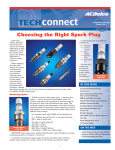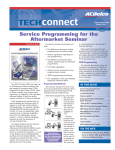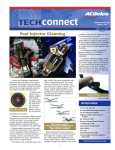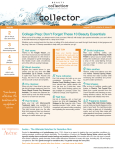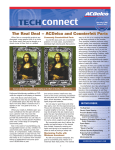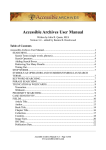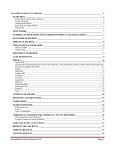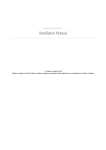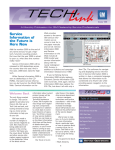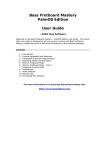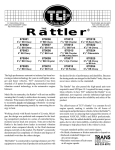Download Charge! New Regulated Voltage Control System
Transcript
May/June 2005 Volume 12, No.3 Charge! New Regulated Voltage Control System Traditional charging systems use an internal temperature sensor inside the generator to establish generator voltage set points. When the generator is cold, it raises the voltage output set point. When the generator is hot, it lowers the voltage output set point. This type of system tends to overcharge the battery on long trips at highway speeds and undercharge the battery on short trips with low vehicle speeds. Regulated Voltage Control (RVC) is a new dynamic control of the vehicle’s system voltage. It regulates the generator’s output voltage, based mainly on estimated battery temperature and battery state-of-charge. The main benefits of this system are: • Improved fuel economy • Extended battery life • Extended lamp life • Extended switch life GM is using three different generations of RVC systems on a number of new models, including Cadillac CTS, SRX and STS, Chevrolet and GMC full-size trucks and SUVs, Chevrolet Cobalt and Uplander, Buick LaCrosse and Terazza, and Pontiac Grand Prix and Montana SV6. Since the RVC system allows changes to vehicle voltage, up or down, under various scenarios — the battery state of charge and the vehicle’s present electrical needs are two conditions taken into account — the voltmeter may fluctuate. Conventional systems usually maintain a consistent reading of 14 volts. The fluctuation of the RVC system may range between 12 and 14 volts. This is normal system operation. Two RVC Systems There are two types of RVC systems used today — integrated RVC and stand-alone RVC (SARVC). Integrated systems use a battery current sensor to provide a body control module (BCM) the amount the battery is charging or discharging. Accurate voltage measurements are taken through the battery positive voltage and ignition 1-voltage circuits. The BCM then communicates information over serial data circuits for the ECM/ PCM to directly control the generator. SARVC systems do not use the BCM for operation. They have a generator battery control module mounted to the negative battery cable, to interpret battery current, and voltage and battery temperature inputs. The battery current sensor is internal to the module. This module also directly controls the generator Lterminal duty cycle instead of the ECM/PCM. Both types of system have two types of corrective actions to insure the battery stays at an 80% state of charge. These include up to three levels of load shed and up to three levels of idle boost operation. System Operation The basic operation of the RVC system is covered here, but not all systems will enter all modes of operation; refer to the applicable service manual information for more details. The purpose of the RVC system is to maintain the battery state-of-charge at 80% or above and support vehicle loads. The six modes of operation include: • Charge Mode • Fuel Economy Mode • Voltage Reduction Mode • Start Up Mode • Windshield De-ice Mode • Battery Sulfation Mode The PCM/ECM (generator battery control module on full-size trucks) controls the generator through the generator L-terminal control circuit. It monitors the generator performance though the generator field duty cycle signal circuit. The signal is a 5 volt PWM (pulse width modulated) signal of 128 Hz with a duty cycle of 0-100%. Normal duty cycle is between 595%. The ranges between 0-5% and 95-100% are for diagnostic purposes. The accompany1 ing table shows the commanded duty cycle and output voltage of the generator. The generator proDuty Generator vides a feedback signal Voltage Cycle of the generator load Set Point through the generator 10% 11.0V field duty cycle signal 20% 11.56V circuit to the control 30% 12.12V module. The signal is a 5 volt PWM signal of 40% 12.68V 128 Hz, with a duty 50% 13.25V cycle of 0-100%. 60% 13.81V Normal duty cycle is 70% 14.37V between 5-99%. The ranges between 0-5% 80% 14.94V and 100% are for 90% 15.5V diagnostic purposes. Charge Mode – The control module enters Charge Mode whenever one of the following conditions is met: • Under WOT conditions and when the fuel rate (sent by the ECM/PCM) is greater than 21 g/s and the throttle position is greater than 90%. • The headlamps are on, low or high beam. • The wipers are on for more than 8 seconds. • The electric cooling fans are on high speed. • The rear defogger is on. • The Battery SOC (state of charge) is less than 80%. continued on page 3 IN THIS ISSUE New Regulated Voltage Control System . .1 Fuel Tank Module/ Fuel Pump Module Connector . . . . . . . .2 Incorrect Placement of Inboard and Outboard Brake Pads . . . . . . . . . . . . . . .2 DEX-COOL and Conventional Engine Coolant . . . . . . . . . . . . . . . . . . . . .4 Measuring Coolant . . . . . . . . . . . . . . . . . . . .4 Vehicle Service Contract Program . . . . . . .5 Keeping Current in Air Conditioning . . . . .5 Service Advisor Seminar . . . . . . . . . . . . . . .6 Sports Report . . . . . . . . . . . . . . . . . . . . . . . . .6 Tech Tips . . . . . . . . . . . . . . . . . . . . . . . . . . . . .7 Tell Us about Your TechConnect . . . . . . . . .8 acdelcotechconnect.com Replace the Connector When Replacing Fuel Tank Module/Fuel Pump Module Anytime the fuel tank module/fuel pump module is replaced on 1999-2003 Cadillac Escalade; 1996-2001 Chevrolet Suburban, GMC Suburban and GMC Yukon XL; 19962003 Chevrolet Silverado, Chevrolet Tahoe, GMC Sierra and GMC Yukon models (excludes 2003 E85 flexible fuel vehicles and diesel vehicles), the Metri-Pack 150 connector (ACDelco part number PT2054) also should be replaced. It’s important to note that not all vehicles use the Metri-Pack 150 connector. This information does not apply to vehicles equipped with the GT 280 connector. The Metri-Pack 150 connector should be replaced because any residual damage to the connector may result in a voltage drop across the module, which can lead to repeat failures. When replacing the connector, be sure to use the splice sleeves provided due to the exposure to moisture. Refer to ACDelco bulletin 05D-J-069, which revises ACDelco bulletin 05D-J-052, for more information. – Thanks to Metri-Pack 150 Connector GT 280 Connector Dennis Kissack Possible Incorrect Placement of Inboard and Outboard Brake Pads ACDelco TechConnect is published bi-monthly for retail technicians to provide timely service information, increase knowledge and improve the performance of the service center. Publisher & Editor: Greg Baker ACDelco E-mail / [email protected] Technical Editors: Mark Spencer E-mail / [email protected] Jim Horner E-mail / [email protected] Desktop Publishing: Greg Szpaichler, MediaWurks E-mail / [email protected] Write to: * ACDelco TechConnect P.O. Box 500 Troy, MI 48007-0500 : On the Web: acdelcotechconnect.com The inboard pad, right, on the 17D-727 brake pad set can be identified by a taller center-positioning tab and the wear indicator. The inboard brake pad on 17D-727 brake pad sets can be installed in the outboard position on 1997-2005 Chevrolet Malibu; 1997-1999 Oldsmobile Cutlass; and 1999-2004 Oldsmobile Alero and Pontiac Grand Am models. The incorrect placement of the inboard pad in the outboard position on this design of caliper may result in caliper slide movement, rapid pad wear, possible binding and overheating of the brakes. If the pads are incorrectly placed, the caliper sliding action will be restricted and pad to rotor contact will always be present, contributing to pad wear and noise. The outboard pad will not easily install in the outward mounting bracket ears, but it can be forced into position. Unlike many pads that have the wear indicator mounted on the outboard pad, the wear indicator clip on the 17D-727 pad sets is installed on the pad that is mounted inboard. There are several differences that can be noted to identify the inboard pad from the outboard pad. The inboard pad with the wear indicator on these pad sets has a taller center-positioning tab than the outboard tab. The inboard pad also has a thicker metal backing and a thinner friction block than the outboard pad. When installing the pads, do not grind the length of the center-mounting tab enable the wrong pad to the mounted outboard. If the center-positioning tab appears to be too long, the pads are mounted incorrectly. Refer to ACDelco bulletin 05D-J-076 for more information. – Thanks to Dennis Kissack 2 ACDelco service tips are intended for use by professional technicians, not a “do-it-yourselfer.” They are written to inform those technicians of conditions that may occur on some vehicles, or to provide information that could assist in the proper service of a vehicle. Properly trained technicians have the equipment, tools, safety instructions and know-how to do a job properly and safely. If a condition is described, it cannot be assumed that the information applies to all vehicles or that all vehicles will have that condition. All materials and programs described in this magazine are subject to change. Submission of materials implies the right to edit and publish. Inclusion in the publication is not necessarily an endorsement of the individual or the company. TechConnect is published for ACDelco by Sandy Corporation, Troy, MI. ©2005 ACDelco. All rights reserved. Charge! New Regulated Voltage Control System When one of these conditions is met, the control module ramps up the voltage slowly to a level between 13.4 to 15.5 volts (depending upon the mode of operation the system is presently in) at a rate of 8 mV to 50 mV per second. Fuel Economy Mode – The control module enters Fuel Economy Mode when the following conditions are met: • The calculated ambient air temperature is above 0°C (32°F). • The calculated battery current is less than 15 amperes and greater than -8 amperes. • The battery state of charge is greater than 80%. • The generator field duty cycle is less than 99%. Its targeted generator output voltage is 13.0 volts. The control module will exit this mode once the criteria are met for Charge Mode. Voltage Reduction Mode – The control module will enter Voltage Reduction Mode when the following conditions are met: • The calculated ambient air temperature is above 0°C (32°F). • The calculated battery current is less than 2 amperes and greater than -7 amperes. • The generator field duty cycle is less than 99%. Its targeted generator output voltage is 12.9 volts. The control module will exit this mode once the criteria are met for Charge Mode. Start Up Mode – After the engine has started, the control module sets a targeted generator output voltage of 14.5 volts for 30 seconds. Battery Sulfation Mode – The control module enters this mode when the battery voltage is less than 13.2 volts for 45 minutes. Once in this mode, the generator battery control module will set a targeted output voltage between 13.9 to 15.5 volts for 5 minutes. The control module will then determine which mode to enter depending on voltage requirements. RVC Mode – The control module bases the charging voltage on battery state of charge (SOC). Battery SOC is estimated during a key off event every 8 hours, after 3 voltage measurements every 24 hours thereafter, and then monitored constantly while the ignition is on. These measurements of voltage are then compared to estimated battery temperature, as battery temperature vs. battery voltage directly corresponds to battery SOC. While the engine is running, the system uses both the battery voltage and estimated battery temperature to determine the battery current in and out of the battery. The control module then regulates the charging voltage to keep the battery above an 80% SOC. 95-100% are for diagnostic purposes. Body Control Module (BCM), Instrument Panel Module (IPM) and Dash Integration Module (DIM) – The BCM determines the output of the generator and sends the information to the ECM/ PCM for control of the generator L-terminal control circuit. It monitors the generator field duty cycle signal circuit information sent from the ECM/PCM that determines the generator electrical load. It monitors the battery current sensor, the battery positive voltage circuit, and estimated battery temperature to determine battery state of charge (SOC). The BCM performs, or sends, commands to ECM or other controllers to perform idle boost and load management operations. ECM/PCM – The ECM/PCM directly controls the generator field control circuit input to the generator. The ECM/PCM receives control decisions based on messages from the BCM/ IPM. It monitors the generator field duty cycle signal circuit and sends the information to the BCM/IPM. On some vehicles, the ECM/PCM overrides the control decision of the BCM/PCM when the following conditions are met: • The engine cooling fans are ON high speed. • There is a high fuel demand. • The calculated ambient air temperature is less that 0°C (32°F). Instrument Panel Cluster (IPC) – The IPC provides a means of driver notification in case of a charging system failure. Generator Battery Control Module – It communicates with the PCM, IPC and BCM for RVC operation. It is a serviceable component that is connected to the negative battery cable at the battery. It directly controls the generator field control circuit input to the generator. It monitors the generator field duty cycle signal circuit, its internal battery current sensor, the battery positive voltage circuit, and estimated battery temperature to determine battery state of charge (SOC). General System Diagnostics Diagnostics are specific for each vehicle that uses this system. Refer to the applicable service manual for DTC information. For L-terminal diagnostics, set your DVOM to monitor frequency. When the system is operating normally, you should read a duty cycle of 5-95% depending on which mode the system is in and also the battery SOC. The 5volt reference signal for the PWM signal is provided by the generator and cycled to ground by the ECM/PCM or generator battery control module, depending on the system. For F-terminal diagnostics, set your DVOM to monitor frequency. When the system is operating normally, you should read a duty cycle of 5-99% depending on which mode the system is in and also the battery SOC. The ECM/PCM or generator battery control module, depending on the system, provides the 5-volt reference signal for the PWM signal and is cycled to ground by the generator. A scan tool may include some of the following parameters: ECM/PCM • Generator L-Terminal • Generator F-Terminal • Battery Voltage BCM/DIM/IPM • Battery Current Sensor • Battery Voltage • Ignition Voltage • Load Shed Level • Idle Boost Level The generator battery control module incorporates most of the scan tool parameters, except load shed and idle boost, as this system does not take corrective actions. If there is a charging system error, first check for related charging system and low voltage DTCs set in the control module. In addition, diagnose P codes first, as these DTCs will set if there is a generator or control circuit failure. If no DTCs are present, refer to the Charging System test in the service manual. If this test does not present a failure, it may be necessary to test drive the vehicle and monitor the idle boost and load shed parameters. This may lead you to some type of high load condition that may be normal; compare to a knowngood vehicle. – Thanks to Jim Mauney and John Spidle RVC Systems The following chart shows the different generations of RVC systems currently in use. RVC System Generation Modes of Operation Key Components Vehicles Generation II RVC Mode DIM, PCM 2004 Cadillac CTS Generation II RVC Mode DIM, ECM 2004 Cadillac SRX Generation III Charge Mode and Voltage Reduction Mode Battery Current Sensor, IPM, ECM 2005 Cadillac STS Generation IV Charge Mode, Fuel Economy Mode, Voltage Reduction Mode, Start Up Mode, Battery Sulfation Mode Generator Battery Control Module, ECM/PCM 2005 Full Size Pickups and Utilities under 8600 GVW Generation IV Charge Mode, Fuel Economy Mode, Voltage Reduction Mode, Start Up Mode, Battery Sulfation Mode Battery Current Sensor, BCM, ECM/PCM 2005 Chevrolet Cobalt, Buick LaCrosse Generation IV Charge Mode, Fuel Economy Mode, Voltage Reduction Mode, Start Up Mode, Battery Sulfation Mode Battery Current Sensor, BCM, PCM 2005 Pontiac Grand Prix and Grand Prix GXP, Chevrolet Uplander, Pontiac Montana, Buick Terazza System Components Battery Current Sensor – The battery current sensor is a serviceable component that is connected to the negative battery cable at the battery. The battery current sensor is a 3-wire Hall-effect current sensor that monitors the battery current. It directly inputs to the BCM. It creates a 5 volt PWM signal of 128 Hz with a duty cycle of 0-100%. Normal duty cycle is between 5-95%. The ranges between 0-5% and — from page 1 3 DEX-COOL® and Conventional Engine Coolant General Motors and Texaco introduced DEX-COOL extended-life coolant in 1995. Unlike propylene glycol-based conventional coolant, this new coolant was ethylene glycol-based and did not contain phosphates or silicates. It used a patented long-life organic corrosion inhibitor system that offered protection for the six basic metal alloys — aluminum, brass, cast iron, steel, solder and copper — found in most automotive cooling systems. These enhanced properties of DEX-COOL protect the cooling system components for a longer service life of 5 years/150,000 miles. Conventional coolant has a 2-year/30,000-mile service interval. To distinguish DEX-COOL from green conventional coolant, DEX-COOL is made orange in color. After a period of use, however, DEXCOOL may appear pink. This change in color does not affect the integrity of the coolant and it still maintains its long service life. In addition, the repeated use of seal tabs in the cooling system may also discolor the coolant. Corrosion protection limits the service life of conventional coolant to its 2 year/30,000 mile service interval. The corrosion inhibitors in DEX-COOL remain above 95% of their original concentration after 150,000 miles, allowing for the much longer service interval. The corrosion inhibitors of conventional coolant also are abrasive to water pump seals. With the elimination of typical inhibitors such as silicates, phosphates, borates, nitrites and nitrates, water pump seal life is increased. Checking the Coolant To reduce the chance of overheating and other problems caused by the poor condition of the coolant, check the coolant level and its condition regularly using a quality refractometer. Before topping off a cooling system, first determine if the system is filled with DEXCOOL or conventional coolant. The coolants are compatible with one another, however, mixing the coolants diminishes the extended life properties of DEX-COOL. In addition to proper cooling system operation, it’s important to maintain the proper fill level with DEXCOOL in order to avoid aluminum corrosion. Measuring Coolant The protection offered by engine coolant not only includes protection from freezing or overheating, but corrosion protection as well. A properly maintained coolant mixture protects cooling system components and ensures efficient engine cooling. Corrosion problems originate in the different metals in an engine that can react with corrosive coolant byproducts. To combat this, coolant contains additional chemicals, known as inhibitors, to minimize corrosion. The inhibitors are designed to act as a buffer to protect the cooling system. However, over time, they become depleted and the coolant “wears out.” Check the radiator cap using a pressure tester to ensure it’s operating properly. If a cap fails to hold pressure, it can lead to coolant loss, overheating and system contamination. Approved DEX-COOL Providers ACDelco is one of only six approved providers of DEX-COOL. Simply put, other products that are advertised as “compatible” or “recommended” for use with DEX-COOL have not been tested or approved by GM. Non-approved coolants may degrade the integrity of the cooling system and are not considered 5-year/150,000-mile coolants. Contamination DEX-COOL was not developed to be used with conventional coolant. Mixing DEX-COOL and conventional coolant will degrade the extended service interval of DEX-COOL. This includes simple maintenance procedures such as sharing a fill/drain container as well as topping-off a DEX-COOL-filled system with conventional coolant or adding conventional coolant to the radiator. If contamination between the two coolants does occur, the cooling system must be flushed twice immediately and refilled with a 50/50 mixture of DEX-COOL and clean water in order to preserve the enhanced properties and extended service interval of DEX-COOL. Service The corrosion inhibitors in coolant are used up over time, requiring the coolant to be changed in order to maintain cooling system protection. With a cooling system filled with DEX-COOL, the coolant should be changed after 5 years/150,000 miles using a coolant exchanger. With conventional coolant, the system should be changed every 2 years/30,000 miles. Following these service intervals are critical to proper engine operation. According to the U.S. Department of Transportation, cooling system failure is the leading cause of The measure of a coolant’s freeze protection is its specific gravity, which measures the relative weight of coolant concentrate to the weight of an equal volume of water. By checking specific gravity, a reading of freeze protection also provides a measure of the strength of inhibitors in the coolant, and as a result, corrosion protection. When checking the specific gravity, you must compensate for coolant temperature, because specific gravity readings decrease as the temperature increases. Specific gravity readings are quoted for a corrected 60°F temperature. 4 mechanical breakdowns on the highway. A coolant exchanger can replace virtually all of the old coolant automatically with new coolant. Simply draining the radiator leaves up to half of the old coolant inside the engine block. Using a coolant exchanger with a vacuum feature also enables trapped air to be removed from the cooling system and allows venting of a hot system to relieve system pressure. Approved coolant exchangers are available from SPX through the Dealer Equipment program. Call 1-800-336-6687 to order or for more information. If the vehicle was originally equipped with DEX-COOL and has not had any contamination problems from non-DEX-COOL coolants, the cooling system should be refilled with DEXCOOL. The service interval remains 5 years/ 150,000 miles. Recycling Used DEX-COOL can be combined with used conventional coolant to be recycled. It is then designated as a 2-year/30,000-mile conventional coolant. DEX-COOL can not be recycled in the service center and maintain its extended-life properties. For recycled DEX-COOL that meets GM specifications for extended-life coolant, the only licensed provider is Recycled Fluid Technologies. Conventional coolant may be recycled by utilizing a coolant recycling service either at the service center or at an offsite facility. Conventional coolant recycling also can be accomplished by technicians using the proper recycling equipment and the inhibitor chemicals supplied by the recycling equipment manufacturer. For additional information about DEX-COOL engine coolant, refer to GM bulletin 00-06-02-006A. DEX-COOL is available from ACDelco in one gallon containers (part number 10-101) or 55 gallon drums (part number 10-125). – Thanks to Mark Spencer Coolant refractometer 75232 is an accurate measurement tool for determining the freeze point of coolant. It compensates for coolant temperature and types, unlike a gravity float tester or hydrometer. With only a few drops of coolant, the easy-to-read scale indicates the freeze point, showing belowzero freeze protection at the top of the scale. Coolant that does not offer the proper amount of freeze protection should be replaced. The refractometer is available from Robinair through the Dealer Equipment program. Call 1-800-336-6687 to order or for more information. – Thanks to Mark Spencer ACDelco Vehicle Service Contract Program Brings in New Business With millions of used cars and trucks being sold every year, new owners truly enjoy the peace of mind that comes with a vehicle service contract to help cover the cost of a variety of repairs. Independent automotive dealers sell vehicle service contracts to a number of customers, but in many cases, they don’t have the service bays to perform repairs or the vehicle service contract program they are selling lacks strong financial backing. These are the reasons ACDelco, along with GMAC Insurance and Universal Warranty Corporation, has put together the Vehicle Service Contract program. The new Vehicle Service Contract program gives TSS service centers: • Increased and sustainable income • New customers for current business • Opportunities for additional service revenue The program brings new customers to your TSS service center for covered repair work as well as the opportunity for additional non-covered repairs and future business, all of which can lead to an expansion of your customer base for long-term growth and profitability. The Claims Process Here’s how the program works. An independent automotive dealer sells a customer an ACDelco Vehicle Service Contract. If the vehicle experiences a covered breakdown, the customer calls Universal Warranty Corporation and is directed to the nearest participating ACDelco TSS service center. When the customer comes to your service center for the repair work, you simply call Universal Warranty to verify the contract and attain authorization for repairs. After performing the covered repairs, you collect the deductible amount from the customer and send in the repair order to Universal Warranty, which will send you a check for the completed work. With every customer who comes into your service center with a service contract claim, there is an opportunity to provide normal vehicle maintenance, sell non-covered parts and service, and develop future business by providing service and maintenance on other vehicles owned by the customer. Program Specifications The Vehicle Service Contract program can be compared to a health PPO for a customer’s vehicle. • The participating TSS service center is the “In-Network” provider • The deductible at a TSS “In-Network” provider is $100 • The deductible at all other “Out-ofNetwork” repair facilities is $500. In the program, customers have a $400 incentive to take their service business to your participating TSS service center. There are no fees or sign-up costs to participate in the program, however, because of the competitive vehicle service contract environment, all of the ACDelco Vehicle Service Contract business entities have made concessions to drive down costs. Universal Warranty Corporation and their independent representatives, for example, have reduced their fees for administering the program by 40-to-50 percent. TSS service center participants are required to limit costs by reducing their labor rate and parts charges. The considerable volume of projected new business is expected to compensate for these cost reductions. The ACDelco Vehicle Service Contract program is the only national program of its kind. No other parts suppliers have developed a national program like this one. And it benefits from national support and advertising from ACDelco. To enroll, visit acdelcovsc.com, download the short sign-up agreement and fax the form to 402-691-5455. The web site also provides additional details about the ACDelco Vehicle Service Contract program, including pricing information and helpful “Frequently Asked Questions.” – Thanks to Sheri Sierakowski Keeping Current in Air Conditioning — Emerging HVAC Technology & Service Issues In the lives of automotive technicians and counter support personnel, the ability to remain current on industry developments is difficult. Changes on many fronts from OEMs, tool and equipment suppliers, parts suppliers and governmental regulatory groups all affect the automotive industry and its operation. There are numerous changes but with limited time you only want to know … which ones affect me?! ACDelco has substantially revised its A/C seminar for 2005. And it’s your opportunity to learn more about recent changes and their effect on automotive service. The Emerging HVAC Technology & Service Issues seminar is conducted through a participating ACDelco Dedicated Distributor Group (Warehouse Distributor) in your area. 5 The seminar covers: • Information to reduce costly comebacks • Cooling system updates • New tool and equipment releases • Industry and governmental trends • The latest technical bulletins Seminar handouts provide a ready resource to correct this year’s vehicle problems. In addition, the condensed overview of benefits and options available through new equipment, tools and parts encourages informed customer service. To sign up for the 2005 Air Conditioning seminar, contact your ACDelco DDG representative. – Thanks to Jim Resutek How to Manage the Customer Service Process Service Advisor Seminar Focuses on Customer Satisfaction Think for a second about all of the steps you take in handling one customer who is in your service center for a repair. How many did you count? A successful service experience goes beyond simply greeting the customer, making a diagnosis, performing the repair work and delivering the vehicle. But do you know what you’re missing? And are the things that you’re missing the critical steps needed to ensure customer satisfaction and develop a loyal customer? It is the complete customer service process that is the focus of the ACDelco Business Management Training Service Advisor Seminar. The one-day seminar, BT-4.01, is for TSS service center service advisors as well as employees who may become service advisors. Throughout the course, the various steps and processes that make up the customer service event are reviewed along with the skills required to manage those processes with high customer satisfaction. Eight Areas of a Service Event The seminar covers how to manage eight areas of a service event with a customer in order to ensure a high level of satisfaction. Participants will cover: • Identifying and fulfilling customer needs during the service process • Effective communication and listening skills • The customer experience and the importance of how a customer perceives their service experience • The importance of connecting with customers through behavioral style, behavior patterns and body language • Effective sales techniques using customer-oriented benefit statements and maintenance inspections, and how to handle customer emotions • Writing a clear and concise repair order • Creating exceptional customer service through delivery and follow-up • Developing a personal action plan to use upon returning to the service center Developing an Action Plan At the end of the seminar, participants will put together their own personal action plan that will help them to use what they have learned in the course to improve the customer service process in their service center. They are asked to rate their skill level in the following areas: • The service process • Effective communication skills • The customer experience • Connecting with customers • Effective sales techniques • The repair order • Closing the loop to create exceptional customer service Once participants have identified their strengths, they can then begin to deter- mine in what areas they need to improve and how to implement their action plan. AMI Certified The Service Advisor Seminar is AMI certified. Participants who complete the seminar will receive four credits toward their AAM designation. The Automotive Management Institute’s (AMI) Accredited Automotive Manager (AAM) designation is the first business management accreditation exclusively for the automotive service professional. How to Enroll Visit acdelcotechconnect.com to enroll online; and click on the Training link to go to the Training Delivery System. Registration is required to enroll online. From the Training Delivery System web site main menu, select “Professional Development” and then “Student Enrollment.” To enroll by phone, call the ACDelco Enrollment Center at 1-800-825-5886. When calling to enroll in a course, you will need your ACDelco account number, the last four digits of the social security number of the enrolling student and the course number, date and location. – Thanks to Tracy Betakas Calling All Real Car Guys ACDelco’s highly anticipated 2005 “Pride of the Real Car Guys” contest is almost underway. Want to be featured? Enter a photo of your vehicle, along with the on-line entry form on acdelcotechconnect.com explaining why ACDelco should highlight your ride in its 2006 “Pride of the Real Car Guys” calendar. Entries will be accepted beginning June 1 through July 31, 2005. For more contest details, contact your local ACDelco representative. ACDelco Sports Report NASCAR Busch Series Stock Car Racing Driver: Clint Bowyer Car: #2 Chevy Monte Carlo Richard Childress Racing Clint Bowyer is gunning for the lead in the Busch Series, taking the #2 ACDelco car to two top 5 finishes and five top 10 finishes. IHRA Torco Racing Fuels Pro Modified Series Drag Racing CITGO BASSMASTER Tournament Trail Driver: Harold Martin Car: Pontiac Grand Am After a disappointing first race of the season, Harold Martin came back strong at the IHRA Spring Nationals. Driver: Kurt Johnson Car: Chevy Cavalier Kurt Johnson continues to challenge the leaders in the competitive 2005 NHRA POWERade Pro Stock Series. 2005 Driver Standings (after 5 of 23 races) 2005 Driver Standings (after 9 of 35 races) Points 2005 Driver Standings (after 2 of 12 races) Carl Edwards Clint Bowyer 1418 1229 1. 7. 1. 3. NHRA POWERade Pro Stock Series Drag Racing Quain Scott Harold Martin Points 181 93 1. Dave Connolly 10. Kurt Johnson 6 Points 428 230 Angler: Jimmy Houston Professional Angler Jimmy Houston has another strong year on the 2005 CITGO Bassmaster Tournament Trail. 2005 Angler of the Year Standings (after 6 of 6 tour stops) Points 1. Aaron Martens 117. Jimmy Houston 1392 608 The following technical tips provide repair information about specific conditions on a variety of vehicles. If you have a tough or unusual service repair, the TSS Technical Assistance Hot Line can help. Call 1-800-825-5886, prompt #2, to speak with a technical expert with the latest OEM information. Using a Battery Charger During Programming The programming of modules requires the ignition key to be turned on, without the engine running. This, of course, means that during the programming event, the vehicle’s systems are operating from the vehicle battery. This, in turn, means that the vehicle’s battery must be adequately charged. Ideally, fully charged. It’s recommended not to connect any external power supply to the vehicle battery as a part of the programming procedure. Here are some reasons why a battery charger should not be connected during programming. First, the voltage output of the charger may be higher than normal system voltage, either constantly or in spikes. The programming scan tool commands all modules of the vehicle to “be quiet” except the one being programmed. This is to avoid the confusion of messages on the data line that would result if multiple modules were awake and conversing. However, if the module being programmed sees a voltage above a certain threshold, it may also shut itself down in an act of self-preservation. This will interrupt programming. Another possibility is that some of the other modules may be awakened temporarily as charger voltage varies. This could then result in confusing, unwanted conversations on the data line, interrupting programming. Second, the battery charger output may contain unwanted AC. Although a charger is designed to convert AC (alternating current) to DC (direct current), it’s possible that some of the AC is not rectified, and passes out of the charger as “noise.” This may also be called AC ripple, or artifacts. Regardless, the presence of anything but pure DC can cause interference with the programming process. Before programming, be sure all accessories are turned off. In addition, it’s recommended that you unplug any devices from the vehicle’s accessory power outlets (cigarette lighters) for two reasons. First, the devices are consuming power, which reduces system voltage. And second, some plugged-in devices can cause interference on their own. One such example would be a generic cell phone charger. Debris in Transmission Space Plate 2001-05 GM passenger cars and light-duty trucks equipped with the 4L60-E or 4L65-E automatic transmission. There are several reasons for a 4L60E (RPO M30) or 4L65E (RPO M32) transmission to set a DTC P0756 (2-3 Shift Solenoid Performance). Two possible causes are a cracked, broken or leaking 2-3 shift solenoid and a stuck or hung-up 2-3 shift valve. Another possible cause is chips or debris plugging the filtered AFL oil at orifice 29 on the top of the spacer plate. Because this orifice is so small, it can be plugged by a very small amount of foreign material. Remove the spacer plate and inspect orifice 29 and the immediate area for the presence of chips or debris. Also, inspect the transTypical debris mission case passage directly above this orifice and the valve body passage directly below. Clean the area of any chips or debris found. rate of the cylinder that has the misfire will be as high as 15 mm3. The misfire codes (P0300, P0301-P0308) will set only after the first 90 seconds of engine operation on Federal RPO LB7 engines (30 seconds on California RPO LB7 engines) and will set only when the balancing rate goes above 15 mm3. The normal values that should be seen on the balancing rate parameters will range between -4.0 and +4.0 in Neutral or Park (-6.0 to +6.0 in Drive when the brake is fully applied). Suspect a possible problem when the balancing rate of a particular cylinder starts to increase out of the normal operating range. An example of a possible problem cylinder would be a balancing rate of 7 mm3 or so. Once the numbers start to increase out of the normal range, the cylinder is progressively contributing less power than the other cylinders. Diagnosing "Fuel Knock" Perform the diagnostics listed in the Fuel Knock symptom table of the service information. Vacuum/Pressure Gauge Location of debris in spacer plate orifice 29 Refer to GM bulletin 01-07-30-036D for more information. Duramax Diesel 6.6L Diagnostic Tips Here are some diagnostic tips you may find useful when diagnosing driveability concerns on the Duramax 6.6L diesel engine. Misfire If there is a misfire code, or a misfire can be detected during operation, connect a scan tool and look on the Engine Data 2 list to find the Balancing Rates for the cylinders. Do not use Balancing Rates to diagnose symptoms that do not occur at idle. Use the fuel Injector Balance Test with a scan tool to diagnose symptoms at higher engine and vehicle speeds. Balancing Rates Normal fuel delivery to each cylinder is around 1 cubic millimeter (mm3) for the pilot injection and 7 mm3 for the main injection. The balancing rates are the measurements of the amount of fuel removed from or added to these normal fuel quantities during each combustion event. Balancing rates are available and accurate only during stable idle. These numbers tell you whether or not you have a possible compression, injector control, or injector issue. Once the misfire is detected, the balancing 7 The vacuum/pressure gauge is also useful when diagnosing the Duramax 6.6L diesel. In the case of a condition of “starts, runs, then dies,” or if the vehicle will not start after sitting for a period of 30 minutes or longer, hook up the vacuum/pressure gauge to the Schraeder valve on the right front valve cover to determine if air intrusion into the fuel system is the root cause of the condition. With the vacuum/pressure gauge hooked up, prime the fuel manager until 10 psi is reached. If pressure does not reach 10 psi after twenty or so pumps, air intrusion is the cause. Refer to the fuel system diagnostic in the service information. In the case of a “cranks, no start” condition, use a scan tool to check for codes. If no codes are present, use the vacuum/ pressure gauge Vacuum/Pressure to check the fuel Gauge hookup supply system vacuum to the pump while cranking. If the vacuum increases to more than 5 in. Hg, there is a restriction in the fuel system between the fuel tank and the high pressure pump. If the vacuum is OK, ensure that pressure is being made under Engine Data 1, looking at Actual Fuel pressure. Observe the Engine Cranks but Does Not Run Diagnostic in the service information and follow the guidelines provided in order to determine if the pump or the fuel injectors are the problem. Tell Us about Your TechConnect TechConnect provides retail technicians with the latest information from ACDelco and the automotive industry — all designed to help improve your service knowledge. Each issue features a wide range of topics covering information and programs from ACDelco, GM, TSS program partners, tool suppliers and more. Now, we’d like to get your thoughts. Send us an email answering the following questions. Your feedback and ideas will help in developing future issues of TechConnect that will cover the automotive service news and information you want most. As a way of saying thanks for participating in the survey, we’ll give a premium ACDelco stainless steel travel mug to 10 participants selected from a random drawing of all email responses. Please respond before June 30, 2005, to be eligible for the random drawing. Please reply to the following 10 questions and number your answers 1–10. With your survey response, include your: • • • • • Name Title TSS service center Address Phone number Send your feedback via email to Mark Spencer, technical editor, at [email protected]. Your input and opinions are very important to us. Thanks for taking the time to let us know how we’re doing. ACDelco TechConnect P.O. Box 500 Troy, MI 48007-0500 Change Service Requested TSS-PU-0112-05 Please answer the following questions: 1. What do you find most useful about TechConnect? A. ACDelco product news and information B. TSS program information C. Automotive technology articles D. Other: 2. TechConnect covers a variety of ACDelco product information. I would like more ACDelco product information on . 3. TechConnect features a TSS column with information about the program and its benefits. I would like more TSS program information on . 4. TechConnect covers the latest technical information from ACDelco and General Motors. I would like to see more in-depth articles covering new technology, including . 5. Would more articles about ACDelco training opportunities be helpful? . 6. Would more articles about ACDelco promotions and marketing events be helpful? . 7. Would you like to see more or less coverage of ACDelco motorsports? . 8. Is there anything you would change or add to TechConnect to make it more useful for you? . 9. A printable PDF of each issue of TechConnect is posted on acdelcotechconnect.com. Do you view TechConnect online or print out a copy? . 10. Would you prefer to receive TechConnect electronically in an email or as a paper copy? . PRSRTD STD U.S. POSTAGE PAID DETROIT, MI PERMIT NO. 2621








